In this article, I’m going to lay out a mind-blowing case presenting the Antichrist as being a resurrected Nimrod, and I will explore the prophecies of his briefly victorious war against Heaven, explaining in detail who the man behind the myths really is, as well as identifying the many masks that he has worn throughout history.
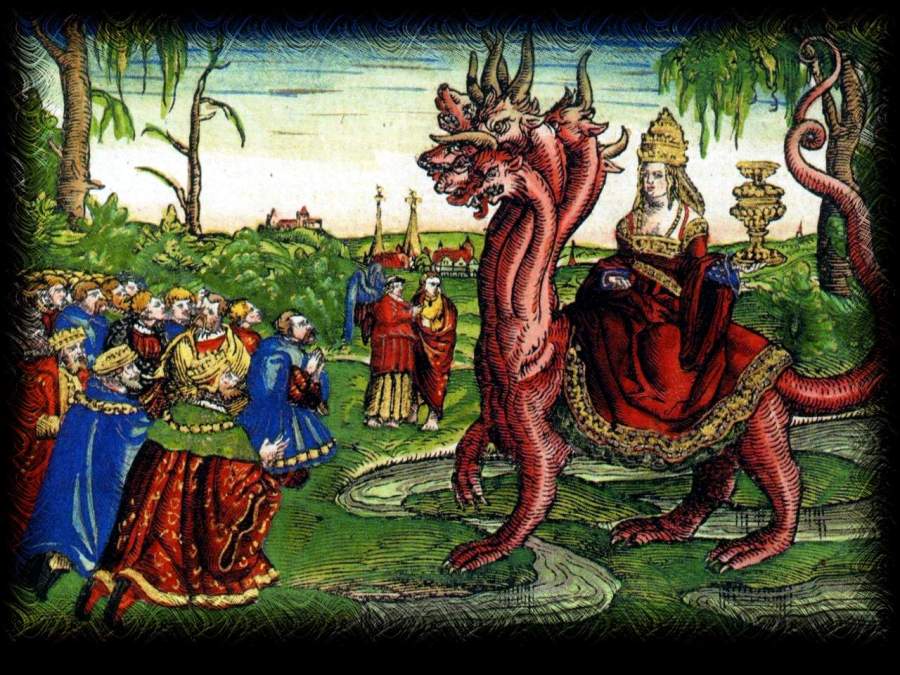
One of the greatest clues as to the identity of the Antichrist is in Revelation 17. The Prophet John is shown a vision of a harlot riding a seven-headed beast. The identity of the harlot is plainly written in verse 5: “Babylon the Great, the Mother of Harlots and abominations of the Earth”, later referred to as “that great city, which reigneth over the kings of the earth.” In verse 9, it is revealed that the seven heads of the beast beneath her represent the seven mountains on which the great city of Babylon sits—mountains also represent kingdoms. Of course, each kingdom has its own king, and so verse 10 reveals a correspondence, that “there are seven kings: five are fallen, and one is, and the other is not yet come; and when he cometh, he must continue a short space.” So, we have here a scale of time, seeing that five of the seven kings had already come and gone before the time of John, and the last two were yet to come.
This image of seven great historical kings illustrate the seven foreshadowing types of the Antichrist throughout the whole of the Babylon world system in its various mutating forms, generally agreed to be Babylon, Egypt, Assyria, Medo-Persia, Greece, the Roman Empire, and a seventh Kingdom, which may have been Nazi Germany; after all, the commonality that defines these seven evil kingdoms is their dominance over God’s chosen people under the rule of a powerful satanically inspired leader.
Here’s a list of seven very famous candidates.

Babylon: Nimrod — became the god-king of a one-world kingdom and sought to usurp Heaven.
 Egypt: Thutmose III — the first pharaoh, a self-proclaimed god who enslaved the Jews and sought to destroy their entire race by having the male children drowned.
Egypt: Thutmose III — the first pharaoh, a self-proclaimed god who enslaved the Jews and sought to destroy their entire race by having the male children drowned.
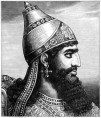
Assyria: Sennacherib — a mighty conquering king who disregarded any god but himself and warred against Judah.
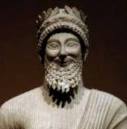
Tyre: Ithobaal III — a Phoenician king, equated with Lucifer in Ezekiel 28, “…thou hast said, I am a God, I sit in the seat of God…”, also a perfect resemblance to Nimrod. Normally, I’d have given this position to Nebuchadnezzar, King of Babylon, but we already covered Babylon with Nimrod, and Nebuchadnezzar ended up converting from his evils and worshipping the true God.
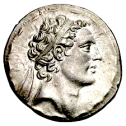
Greece: Antiochus Epiphanes — a Greek tyrant who established an altar of Zeus in the Jewish temple and offered a pig, a foreshadowing of the future Antichrist’s “abomination of desolation.” He forbade the worship of Yahweh under penalty of death.
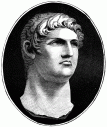
Roman Empire: Nero — a bloodthirsty emperor famous for the gruesome martyring of Christians, lighting some on fire as a lamp for his garden, regarded by the Carthaginian writer Tertullian to be the first persecutor of the Christians, and an excessively violent one.
Nero was the one that existed in the time of John when he wrote of the seven kings, “five are fallen, and one is…” Only one is yet to come after Nero “…and the other is not yet come; and when he cometh, he must continue a short space.”

Nazi Germany: Adolf Hitler — the occult-obsessed Chancellor of Germany, undoubtedly the next great evil leader who followed the perfect antichrist archetype by slaughtering the Jews to the brink of extinction and coming within a breath of seizing all of Europe. His brief but mighty reign in history is the “short space” of time that John prophesied of concerning this seventh king.
These are most likely the seven heads of the beast, and as you can see, the heart of Babylon’s Nimrod was shared by the other six who followed, showing that the same spiritual force was guiding each of these seven great kings. The spirit relating the seven kings was none other than the spirit of Satan himself, as evidenced by the King of Tyre’s comparison to Lucifer in Ezekiel 28, where we see these attributes of striving to usurp God’s throne first manifest in the Devil…
Ezekiel 28:13-17, speaking of both the King of Tyre and Satan — “You were the seal of perfection, full of wisdom and perfect in beauty. You were in Eden, the garden of God; every precious stone adorned you: carnelian, chrysolite and emerald, topaz, onyx and jasper, lapis lazuli, turquoise and beryl. Your settings and mountings were made of gold; on the day you were created they were prepared. You were anointed as a guardian cherub, for so I ordained you. You were on the holy mount of God; you walked among the fiery stones. You were blameless in your ways from the day you were created till wickedness was found in you. Through your widespread trade you were filled with violence, and you sinned. So I drove you in disgrace from the mount of God, and I expelled you, guardian cherub, from among the fiery stones. Your heart became proud on account of your beauty, and you corrupted your wisdom because of your splendor. So I threw you to the earth; I made a spectacle of you before kings.”
It can also be conjectured that these seven kings in Revelation 17 are a dark parallel to God’s seven golden lampstands in Revelation 1. The seven golden lampstands represent the seven Churches that comprise the Body of Christ, Christ Himself standing in the midst of them as their head. In the same fashion, the seven evil kings are the seven temples of Satan, as the human body is regarded as a temple for spiritual indwelling. Just as Christ is the head of his seven accumulated churches, the Antichrist will also be the head of his seven accumulated kingdoms. Where the seven churches make up the Body of Christ, the seven evil kingdoms make up Revelation 17’s “scarlet coloured beast”, the dragon, on which Babylon has ridden throughout history.
But here come’s the real mystery.
Revelation 17:8 explains, “The beast that thou sawest was, and is not; and shall ascend out of the bottomless pit, and go into perdition: and they that dwell on the earth shall wonder, whose names were not written in the book of life from the foundation of the world, when they behold the beast that was, and is not, and yet is.” It adds in verse 11, “And the beast that was, and is not, even he is the eighth, and is of the seven, and goeth into perdition.”
So, the final Antichrist himself is said to have existed, then not existed, and then rises up from the bottomless pit in the end times to fulfill the last war against God. This Antichrist beast has seven heads, and the Antichrist himself is one of the seven—the seven historical tyrants.
“…the beast that was, and is not, even he is the eighth, and is of the seven…” The final eighth antichrist will be one of the seven dead tyrants who came before, resurrected from the dead, as the passage explains how he will “ascend out of the bottomless pit”. The bottomless pit is synonymous with the Greek Septuagint’s “Abyss”, a term for the underworld, a sort of spiritual prison beneath the surface plane of the earth. The word is borrowed from the Greek abussos, meaning “deep”, implying that this “bottomless pit” is indeed what is commonly known as the “underworld.” The Abyss is the realm of the souls of the dead. To “ascend out of the bottomless pit” might mean that the Antichrist, one of the seven tyrants, will rise from the dead and rule the world one last time.
A dead king… So which one? Nimrod? Pharaoh? Sennacherib? The King of Tyre? Antiochus Epiphanes? Nero? Hitler? Each dead king is occupying the Abyss, but which one will rise again as a dark counterfeit to the resurrection of Yeshua?
“And I saw one of his heads as it were wounded to death; and his deadly wound was healed: and all the world wondered after the beast.” (Revelation 13:3) One of the beast’s seven heads—kings—received a fatal wound. Verse 14 then tells us that the False Prophet will tell people to make an image to this resurrected king “which had the wound by a sword, and did live.”
So, which of the seven historical kings were killed by a sword?
Hitler shot himself, or as the unofficial reports say, secretly fled to Antarctica.
Nero had his private secretary Epaphroditos assist his suicide, stabbing himself in the neck with a dagger.
Antiochus died of a disease.
Regarding the King of Tyre, not much is said of his death, except the prophecy in Ezekiel 28, which said to him, “thou shalt die the deaths of them that are slain in the midst of the seas.” Drowned in the ocean, perhaps?
Sennacherib was killed by his two sons, Adrammelech and Sharezer, who smote him with swords.
Little is said about the death of Egypt’s Thutmose III, so a natural death and mummification at the end of a 56-year life is generally agreed
Nimrod, however, was decapitated by a sword.
“And Nimrod and two of his men that were with him came to the place where they were, when Esau started suddenly from his lurking place, and drew his sword, and hastened and ran to Nimrod and cut off his head.” (Jasher 27:7)
If Revelation 13:14 tells us that the Antichrist was one of the seven kings who died by way of a sword. Nero only used a dagger, not a sword, and he couldn’t be the future Antichrist because he was the king that was alive at the time of John, while the beast is said to have occupied the Abyss at the time of John (Rev 17:8,11). That narrows it down to Sennacherib and Nimrod.
Although the text says that one of the beast’s seven heads was wounded to death, this does not imply that it is specifically the king’s head that is wounded. The king is simply represented by the head of the beast. If it were a wound on the king’s head, then we would know right way that the Antichrist is Nimrod, but it merely states that the king himself was slain by the sword. Having said that, I do think it’s interesting that Nimrod’s head was cut off, just like the head of the beast that might possibly represent him. Let’s call it a clue.
In Revelation 9, the fifth angel sounds his trumpet and an angel is permitted to unlock the Abyss—verse 2: “The star was given the key to the shaft of the Abyss. When he opened the Abyss, smoke rose from it like the smoke from a gigantic furnace.” And up come locust-like hordes of demons that proceed to torment people for five months. The clue here is in verse 11—“They had as king over them the angel of the Abyss, whose name in Hebrew is Abaddon and in Greek is Apollyon (that is, Destroyer).” In this verse, we are to understand the name of the King of the Abyss, and it is Apollyon, Abaddon, meaning “Destroyer”. Furthermore, the name is equated with the Roman Orcus, and the Greek Hades, each of which are placed in mythology as the principle god and ruler of the underworld. The name Apollyon, like Orcus and Hades, can also be used to mean the place of destruction, making Apollyon the king and personification of the Underworld. Apollyon/Abaddon, likewise, is both the name of the underworld king as well as the name of the underworld itself, as the Masoretic text of the Old Testament also uses the name Abaddon to be a name for the place of destruction, just as how we might say that the Greek god Hades rules over Hades, as if to say the god Hell rules over Hell.
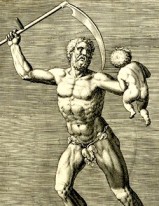 These ideas are parallel to the Roman titan god Saturn, who was cast into Tartarus (the Underworld) following the great Titanomachy—the Battle of the Gods. Saturn is, therefore, the chief underworld god who is no different than Pluto, Dis Pater, Hades, and Orcus. The name Saturnus derives from the Etruscan Satre, referring to a god of the underworld that presided over funerary rites. It is parallel to various names ending in –urnus and –erna which also stem from Etruscan roots—consider Volturnus—so it seems likely that the Etruscan derivation is correct. To support this further, Saturn was linked to a gladiatorial and athletic contests in ancient Rome called munera, public spectacles originally held to honour the funerals of patricians.
These ideas are parallel to the Roman titan god Saturn, who was cast into Tartarus (the Underworld) following the great Titanomachy—the Battle of the Gods. Saturn is, therefore, the chief underworld god who is no different than Pluto, Dis Pater, Hades, and Orcus. The name Saturnus derives from the Etruscan Satre, referring to a god of the underworld that presided over funerary rites. It is parallel to various names ending in –urnus and –erna which also stem from Etruscan roots—consider Volturnus—so it seems likely that the Etruscan derivation is correct. To support this further, Saturn was linked to a gladiatorial and athletic contests in ancient Rome called munera, public spectacles originally held to honour the funerals of patricians.
When you think Saturn, think underworld.
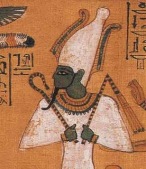 Digging further back, the Egyptian god of the underworld from which this Greco-Roman deity derived is called Osiris. He was called the god of the dead, the afterlife, and the realm of Duat. Duat is the name of the Egyptian underworld, and is what Kabbalists call Da’at, or Daath, which is equated with the Biblical Abyss, said in Jewish mysticism to be the mystical location where all ten sephiroth in the Tree of Life are united as one.
Digging further back, the Egyptian god of the underworld from which this Greco-Roman deity derived is called Osiris. He was called the god of the dead, the afterlife, and the realm of Duat. Duat is the name of the Egyptian underworld, and is what Kabbalists call Da’at, or Daath, which is equated with the Biblical Abyss, said in Jewish mysticism to be the mystical location where all ten sephiroth in the Tree of Life are united as one.
If Duat is the same as the Abyss, then Osiris is the same as Apollyon.
Osiris is the same as the Greek Dionysos, clarified by the Greek historian Mnaseas of Patrae, “Dionysos and Osiris are the same, who are called Epaphus.”
The ancient Greeks also recognized that Shiva was the Indian form of Dionysos, as the two characters paralleled each other in themes of wine, ecstasy, fertility, snakes, the bull, the mountains, frenzied women in nocturnal rites with drums and dances, and many other commonalities. The Dionysian Mysteries eventually changed its nature according to the cult of Shiva, and the traditional panther exhibited in its rites was eventually replaced by Shiva’s tiger after the Greeks had colonized part of India.


I want to also note that the three-pronged trishula of Shiva is the same as the trident wielded by Neptune/Poseidon, Greco-Roman god of the sea—the sea, the deep, is a type of abyss, and therefore a symbol of the underworld, identifying Neptune as the same as Hades/Osiris/Saturn. This is why the Devil is often portrayed with a pitchfork.
It is safe to say that Saturn, Osiris, Dionysos, and Shiva are all the same deity. This god is who Revelation 9:11 calls by name: Apollyon. Shiva is also given the same title as the one placed on Apollyon in the Bible: the Destroyer.
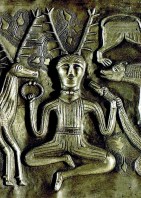 Most scholars agree that Apollyon is no different than the Greek Apollo, both names meaning “Destroyer”. The Hebraic translation, Abaddon, comes from the root word abadir (serpent) and On (an epithet for the Egyptian sun-god), effectively meaning a “serpent-sun god”. The serpent was sacred to Shiva, and he is almost invariably depicted as holding a snake. This is the same as the Celtic Cernunnos, who, just like Shiva and Dionysos, is usually depicted wielding a snake and stands at the centre of the cult of serpent worship. Cernunnos comes from the Semitic root qrn, meaning “horn”, same as the Greek Kronos, both Cernunnos and Kronos meaning “horned one”, which is why the Greek Pan, equivalent to Kronos, is depicted with horns, just like Cernunnos. Kronos and Pan are the Greek names for Saturn.
Most scholars agree that Apollyon is no different than the Greek Apollo, both names meaning “Destroyer”. The Hebraic translation, Abaddon, comes from the root word abadir (serpent) and On (an epithet for the Egyptian sun-god), effectively meaning a “serpent-sun god”. The serpent was sacred to Shiva, and he is almost invariably depicted as holding a snake. This is the same as the Celtic Cernunnos, who, just like Shiva and Dionysos, is usually depicted wielding a snake and stands at the centre of the cult of serpent worship. Cernunnos comes from the Semitic root qrn, meaning “horn”, same as the Greek Kronos, both Cernunnos and Kronos meaning “horned one”, which is why the Greek Pan, equivalent to Kronos, is depicted with horns, just like Cernunnos. Kronos and Pan are the Greek names for Saturn.
In ancient Mesopotamia, the deity was considered a moon-god, called Nanna, Suen, or Sin, represented by the symbol of the crescent. Sin was given the same title as the Roman Saturn, “Chief of the Gods”, as well as the same title as the serpent who tempted Eve in the Garden of Eden, “Lord of wisdom”, who is named in Sumerian myth Enki. In fact, the Roman Saturn’s depiction as riding a chariot driven by dragons is supposed to convey Satan who “rode” the serpent in Eden, that is to say that the Devil used the serpent as a vehicle—Saturn’s “chariot”.
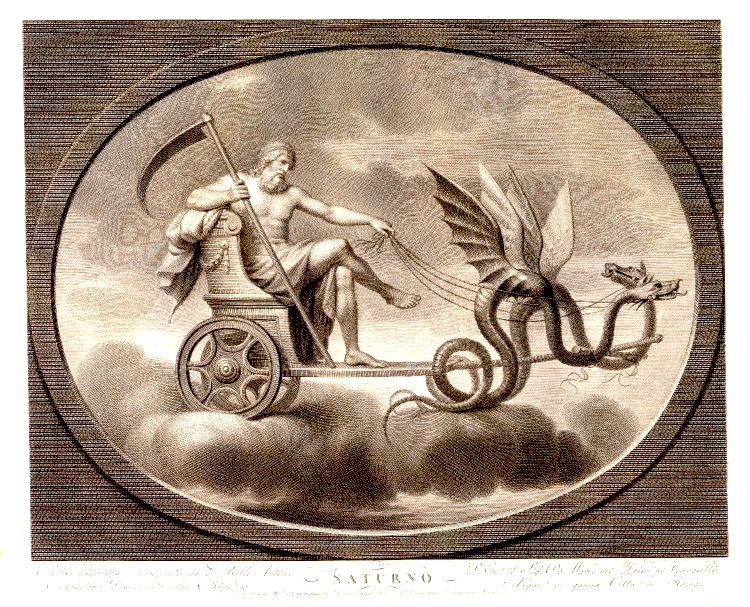
This idea of the devil having dual forms, firstly a serpent, and secondly a wise old bearded man, is manifest later in Greek mythology as Typhon, the half-man, half-serpent king of the monsters; and it is also found in the feathered serpent god of the Mayans, Kukulkan, or Quetzalcoatl, who took the alternate form of a wise Caucasian man with long white hair who came to teach the Mesoamericans—and this description is found in writings from long before they had seen the European settlers who came later. They illustrated this dual-formed god as a gargantuan serpent regurgitating a human from its mouth, an image that was later adopted as the emblem for the illustrious Italian noble family known as the House of Visconti.
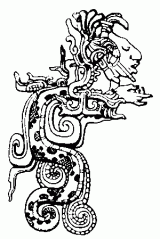
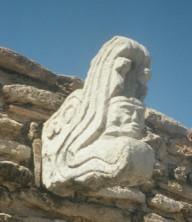
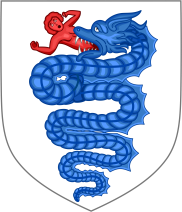
Now, back to Mesopotamia. The Sumerian moon-god called Sin was 
designated the “creator of all things”, which suggests that he was more than just a “moon god”. On one particularly notable kudurru, a Sumerian boundary stone depicting the tale of creation, we find a great serpent drinking from the bowl formed by the lunar crescent of the moon-god Sin, the light of the moon representing in many Eastern cultures the sacred liquid soma of immortality being consumed to sustain the serpent’s perpetual renewal and transformation. There is a distinct and prominent relationship between the serpent and the moon, both of which go through constant cycles of shedding their forms and being reborn, the snake losing its skin and the moon darkening its light.
What is the connection between the serpent and the god Sin? First, let’s closer examine this moon-god.
The god Sin was mostly symbolized by the crescent of the moon, which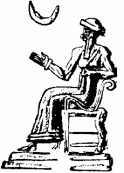 was not only the bowl of the serpent’s soma, but also the symbol of a bull’s horns, giving rise to the later concept of the bull being the sacred animal of the Egyptian god Osiris. Bulls also stand as a symbol of fertility, so this Osirian icon became the idea behind the Greek he-goat Pan being a lascivious and sexually potent god—I believe the term is horny. The symbol later manifested as the bull-headed idol of Baal, Moloch, to which the Canaanites and Phoenicians used to sacrifice their children. To the Canaanites, this god was the paramount
was not only the bowl of the serpent’s soma, but also the symbol of a bull’s horns, giving rise to the later concept of the bull being the sacred animal of the Egyptian god Osiris. Bulls also stand as a symbol of fertility, so this Osirian icon became the idea behind the Greek he-goat Pan being a lascivious and sexually potent god—I believe the term is horny. The symbol later manifested as the bull-headed idol of Baal, Moloch, to which the Canaanites and Phoenicians used to sacrifice their children. To the Canaanites, this god was the paramount 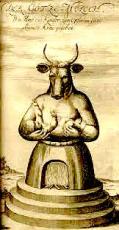 deity known as El, which in arabic was called Al-Ilah, meaning “The God”, or “Supreme Creator”. Al-Ilah was later turned into “Allah”, which is why the symbol of Islam is the crescent moon. The crescent symbol prevailed even to the East, which is why the Hindu god Shiva is always depicted with a crescent moon ornamenting his hair. You might even relate the shape of the crescent moon to the sickle, or harvesting scythe, wielded by Saturn in classical illustrations. Being Lord of the Underworld, a dead god-king from ancient times, Saturn/Osiris was also related to the moon as its crescent travelling against the night sky appeared like a boat drifting along the dark rivers of the underworld. Sin/Osiris was, therefore, no longer the living sun-god Shamash, but being dead, he was now the moon, an illuminator bound in death and darkness, an enlightener locked in the underworld, while his son Dumuzi/Horus replaced him as the sun-god Shamash, told by the Greeks as Zeus replacing his father Kronos, or by the Romans as Jupiter succeeding his father Saturn. Think also of the
deity known as El, which in arabic was called Al-Ilah, meaning “The God”, or “Supreme Creator”. Al-Ilah was later turned into “Allah”, which is why the symbol of Islam is the crescent moon. The crescent symbol prevailed even to the East, which is why the Hindu god Shiva is always depicted with a crescent moon ornamenting his hair. You might even relate the shape of the crescent moon to the sickle, or harvesting scythe, wielded by Saturn in classical illustrations. Being Lord of the Underworld, a dead god-king from ancient times, Saturn/Osiris was also related to the moon as its crescent travelling against the night sky appeared like a boat drifting along the dark rivers of the underworld. Sin/Osiris was, therefore, no longer the living sun-god Shamash, but being dead, he was now the moon, an illuminator bound in death and darkness, an enlightener locked in the underworld, while his son Dumuzi/Horus replaced him as the sun-god Shamash, told by the Greeks as Zeus replacing his father Kronos, or by the Romans as Jupiter succeeding his father Saturn. Think also of the 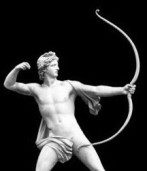 arched shaped of a crescent as the symbol of a bow. This is why the Greek god Apollo is later depicted with a bow, and why the Antichrist as the rider on the white horse in Revelation 6:2 is holding a bow, as Apollo and Apollyon the Antichrist are the same. In mythology, he is a god of oaths, seeing as the bow is the symbol of a covenant—think of God’s rainbow created as His promise or oath never to flood the world again—and so the Zoroastrian god Mithra, the Vedic Mitra, is the god of covenant and oath, his name literally meaning “covenant”, “contract”, or “oath” in the Avestan language. For you prophecy scholars, you might recall that one of the Antichrist’s defining acts is foretold in Daniel 9:27, where it is said that “he shall confirm the covenant with many for one week.”
arched shaped of a crescent as the symbol of a bow. This is why the Greek god Apollo is later depicted with a bow, and why the Antichrist as the rider on the white horse in Revelation 6:2 is holding a bow, as Apollo and Apollyon the Antichrist are the same. In mythology, he is a god of oaths, seeing as the bow is the symbol of a covenant—think of God’s rainbow created as His promise or oath never to flood the world again—and so the Zoroastrian god Mithra, the Vedic Mitra, is the god of covenant and oath, his name literally meaning “covenant”, “contract”, or “oath” in the Avestan language. For you prophecy scholars, you might recall that one of the Antichrist’s defining acts is foretold in Daniel 9:27, where it is said that “he shall confirm the covenant with many for one week.”
The crescent symbol has taken many evolutionary forms in the pagan world, but it can be traced as far back as the crescent moon of the Sumerian god Sin. The relationship then between the serpent and the moon-god Sin is the same as the fusion between the two forms of the Mayan Kukulkan, the duality of the man-snake Typhon, and the depiction of Saturn charioted by dragons. It is the relationship between the serpent in the forbidden tree of Eden and the later figure renowned in myth as the “father of the gods”. What binds the two is the spirit of Satan himself, as these two characters were the two greatest vehicles of the Devil throughout history, mentioned in the prophecy of Revelation 16:13 as the Dragon and the Beast (Antichrist)—the serpent and the man. Along with these two, the False Prophet completes the unholy trinity.
It is, in fact, this Mesopotamian moon god Sin that forms the name of the third historical antichrist type after Nimrod, the third head of the seven-headed beast, King Sennacherib of Assyria, meaning “Sin (the moon-god) has increased the brothers”.
Every one of the gods we’ve reviewed thus far—Cernunnos, Saturn, Orcus, Hades, Kronos, Pan, Shiva, Osiris, Sin, Apollo and Apollyon—are the same.
The mystery is, what was this god’s original identity?
If Nimrod is the same as Apollyon, king over the demons of the Abyss, then he is in fact the eighth and final antichrist that rises from the Underworld, that is, he is the one of seven kings who comes back to life.
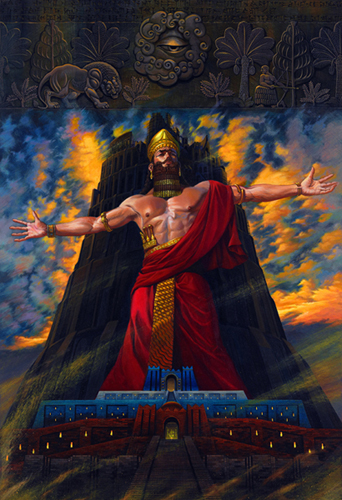
Various cultures in diverse parts of the world have spoken of this ancient figure, because the time of this god was the time before all these people were divided into different cultural language groups, when the world was wholly united—Babel, the Kingdom of Nimrod. Under various names, in various languages, the people continued to speak of this ancient god-king. There was no difference in the origin of the pagan religion, just a confusion of tongues. In the West, the Romans took from the Greeks, the Greeks took from the Egyptians, and the Egyptians took from early Babylon. In the East, Buddhism stemmed from Hinduism, which stemmed from the Indo-Iranian religion, which stemmed from the Assyro-Babylonian religion. All pagan origins trace back to the unified world empire of Babylon.
Nimrod is speculated to be the same as who history has known as Sargon of Akkad, “the true king”. Nimrod is also known as the war-god Asshur, which brought forth the name Assyria, corresponding to the Antichrist’s title in Isaiah 10:5, “the Assyrian”; and in verse 12, “the King of Assyria”. Nimrod was, in fact, the founder of the first imperial powers of Babylon and Assyria. Further connecting Nimrod to both the Antichrist and “the Assyrian”, Micah 5:6 says, “They will rule the land of Assyria (erets Asshur) with the sword, the land of Nimrod (erets Nimrod) with drawn sword. He will deliver us from the Assyrian (Asshur) when he invades our land and marches into our borders.”
Nimrod’s major feat was not just the construction of the Tower of Babel, but it was supposed to be the successful war against God and His angels. The tower was supposed to be his means of reaching heaven with his earthly armies and overthrowing the heavenly government to become God himself.
THE TOWER OF BABEL
The ancient king of the first world empire, Babel, had a tower built in the land of Shinar, the land we know as Mesopotamia. At this time, the whole earth spoke one language.
“And they said, Go to, let us build us a city and a tower, whose top may reach unto heaven; and let us make us a name, lest we be scattered abroad upon the face of the whole earth.” (Genesis 11:4)
The people feared that God would scatter them abroad if they didn’t build this tower, an astute premonition, as this is exactly what God eventually did to them.
“And the Lord came down to see the city and the tower, which the children of men builded. And the Lord said, Behold, the people is one, and they have all one language; and this they begin to do: and now nothing will be restrained from them, which they have imagined to do. Go to, let us go down, and there confound their language, that they may not understand one another’s speech. So the Lord scattered them abroad from thence upon the face of all the earth: and they left off to build the city.” (Genesis 11:5-8)
The interesting point of this is that they thought building this tower would somehow prevent God from scattering them. How can you prevent God from doing anything? As they said, their ambition was to “reach unto heaven.” They were endeavouring to literally enter the heavenly realm and war against God for the seat of Heaven. Why else would they suppose that constructing a “tower” could foil God’s plan?
For further information, let’s search the inspired texts not counted in our Bible—namely, the Book of Jasher. Many are skeptical about this book’s credence, but it was, in fact, referenced to in 2 Samuel 1:18—“Also he bade them teach the children of Judah the use of the bow: behold, it is written in the book of Jasher.” It is also mentioned in Joshua 10:13—“Is not this written in the book of Jasher?”
So, what do these seldom known scriptures of Jasher tell us about the Tower of Babel…
“And king Nimrod reigned securely, and all the earth was under his control, and all the earth was of one tongue and words of union. And all the princes of Nimrod and his great men took counsel together; Phut, Mitzraim, Cush and Canaan with their families, and they said to each other, ‘Come let us build ourselves a city and in it a strong tower, and its top reaching heaven, and we will make ourselves famed, so that we may reign upon the whole world, in order that the evil of our enemies may cease from us, that we may reign mightily over them, and that we may not become scattered over the earth on account of their wars.” (Jasher 9:20,21)
Reviewing the passage, we see a declaration by the royal family heads of Babylon to overthrow God’s government and even reign over the angels as the new overlords of the world. To prove these motivations, let’s read further…
“And the building of the tower was unto them a transgression and a sin, and they began to build it, and whilst they were building against the Lord God of heaven, they imagined in their hearts to war against him and to ascend into heaven. And all these people and all the families divided themselves in three parts; the first said We will ascend into heaven and fight against him; the second said, We will ascend to heaven and place our own gods there and serve them; and the third part said, We will ascend to heaven and smite him with bows and spears.” (Jasher 9:25,26)
The plan was to ascend into the heavenly realm of God where they would try to kill God and his angelic army. They wanted to convert the heavenly sanctuary into a temple for their own gods, one of whom was King Nimrod himself, who was indeed regarded as semi-divine, also known by his Akkadian title, Gilgamesh, described more lucidly in the Epic of Gilgamesh—“the great gods made his beauty perfect, surpassing all others, terrifying like a great wild bull. Two thirds they made him god and one third man.”
Like the hybrid angel-human offspring of the pre-Flood era, called “Nephilim” in Genesis 6, Nimrod is also depicted as having been endowed with these special celestial (demon) genes. This DNA had infected everyone in the antediluvian era and was the main reason for the Flood. The Bible says that Noah and his blood family were not corrupted—that is, they were not of the Nephilim family—but this DNA may have been passed on to the post-Flood world through the wife of Noah’s son Ham, who survived on the Ark and begat Cush, Nimrod’s father. The Nephilim genes may have been dormant in Cush, Mrs. Ham, and their close ancestors, not manifesting in any significant way until the birth of Nimrod generations later, when this one child would mystically become different than his ancestors, a “mighty warrior”, god-like in some regard.
Now, considering the Tower of Babel, the illustration of this project does indeed appear to depict a construction of tremendous height…
“And when they were building they built themselves a great city and a very high and strong tower; and on account of its height the mortar and bricks did not reach the builders in their ascent to it, until those who went up had completed a full year, and after that, they reached to the builders and gave them the mortar and the bricks; thus was it done daily. And behold these ascended and others descended the whole day; and if a brick should fall from their hands and get broken, they would all weep over it, and if a man fell and died, none of them would look at him.” (Jasher 9:27,28)
In that passage, we see that they were making an actual building with classic brick construction. Somehow, the heavenly realm was thought to be accessible by reaching a certain elevation into the atmosphere. The people of Babel got partway through the tower’s construction, and then attacked.
“And the Lord knew their thoughts, and it came to pass when they were building they cast the arrows toward the heavens, and all the arrows fell upon them filled with blood, and when they saw them they said to each other, Surely we have slain all those that are in heaven. For this was from the Lord in order to cause them to err, and in order; to destroy them from off the face of the ground. And they built the tower and the city, and they did this thing daily until many days and years were elapsed.” (Jasher 9:29-31)
Clearly, they continued to build under the false motivation that their tower would succeed, as God deliberately bloodied their arrows to fuel their delusion. But as we all know, in the end, God foiled their project by dividing their unified tongue into multiple languages.
The tower failed.
“So the Lord scattered them abroad from thence upon the face of all the earth: and they left off to build the city. Therefore is the name of it called Babel; because the Lord did there confound the language of all the earth: and from thence did the Lord scatter them abroad upon the face of all the earth.” (Genesis 11:8,9)
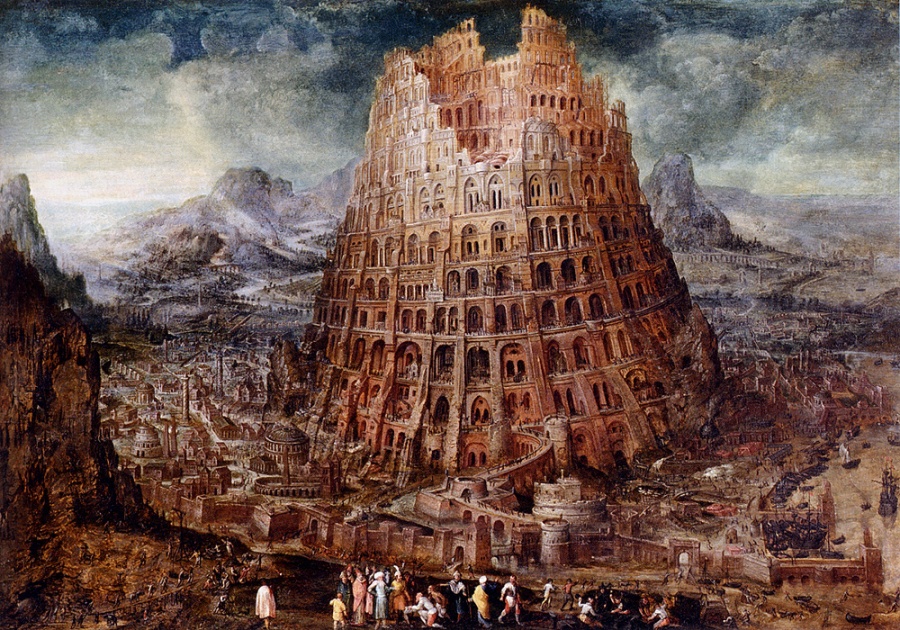
ARMAGEDDON
Interestingly, from the Babylonian point of view, the name Babel, or Babylon, meant something quite different. The Sumerian name of the city was Bab-ilim, meaning the Gate of the Deity, the same as the Akkadian Bab-ilu (Gate of God). Nimrod’s great tower was considered a divine gate. To where? To God, no less. It was this tower that was thought to be the gateway between heaven and earth, a passageway by which the evil king and his armies could usurp the throne of the Most High. Nimrod’s ambitions were one with the Devil’s—truly, the son of Satan, a perfect imitative obverse of the Lord Yeshua HaMashiach.
A fitting character to play the Antichrist, no?
“The beast that thou sawest was, and is not; and shall ascend out of the bottomless pit, and go into perdition: and they that dwell on the earth shall wonder…” (Revelation 17:8)
“…the beast that was, and is not, even he is the eighth, and is of the seven…” (Revelation 17:11)
“And I saw one of his heads as it were wounded to death; and his deadly wound was healed: and all the world wondered after the beast… which had the wound by a sword, and did live.” (Revelation 13:3,14)
To rise from the underworld is to return to life. Nimrod was slain by the sword—beheaded—and will by some means be resurrected. To corroborate this idea, let’s read what was prophesied about the ambitions of this final Antichrist…
“And out of one of them came forth a little horn (Antichrist), which waxed exceeding great, toward the south, and toward the east, and toward the pleasant land. And it waxed great, even to the host of heaven; and it cast down some of the host and of the stars to the ground, and stamped upon them. Yea, he magnified himself even to the prince of the host, and by him the daily sacrifice was taken away, and the place of the sanctuary was cast down.” (Daniel 8:9-11)
The word for host in the Hebrew is tsaba, meaning “army”; and the word heaven is shamayim, meaning “heaven”, or “sky”. Shamayim is equal to the Greek ouranos, describing the heavenly location of God’s sanctuary in Hebrew 9:24—“For Christ did not enter a holy place made with hands, a mere copy of the true one, but into heaven itself.” Various passages depict a sanctuary in heaven after which the earthly tabernacle was originally patterned, such as, “A minister (Christ) of the sanctuary, and of the true tabernacle, which the Lord pitched, and not man.” (Hebrews 8:2) “Who serve unto the example and shadow of heavenly things, as Moses was admonished of God when he was about to make the tabernacle: for, See, saith he, that thou make all things according to the pattern shewed to thee in the mount.” (Hebrews 8:5) “It was necessary, then, for the copies of the heavenly things to be purified with these sacrifices, but the heavenly things themselves with better sacrifices than these.” (Hebrews 9:23)
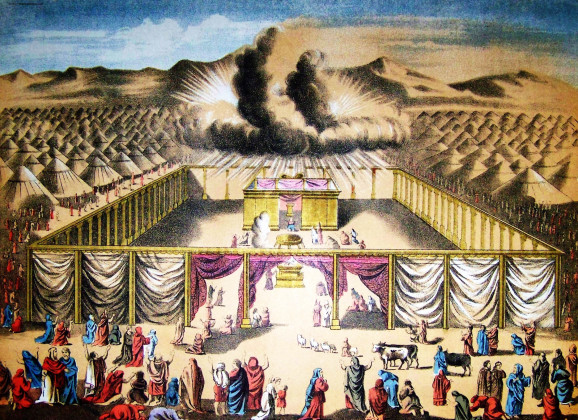
Reflecting on the prophesy of Daniel 8, we see that the “little horn”, who is the Antichrist, not only aspires to war against heaven, but succeeds in confronting the “host (army) of heaven… and it cast down some of the host and of the stars (angels) to the ground, and stamped upon them.”
This is exactly what Nimrod strode to accomplish but failed to. Will he return in the final battle to finish what he started, and even succeed to a certain extent, bringing into the modern world arcane knowledge as to how to construct a new, better Tower of Babel, a gate to God?
One of the most convincing clues that Nimrod will be the one of seven kings who returns to become the eighth is that the Antichrist’s ambitions described in Daniel run parallel to his ambitions when he was first alive—“…and whilst they were building against the Lord God of heaven, they imagined in their hearts to war against him and to ascend into heaven. And all these people and all the families divided themselves in three parts; the first said We will ascend into heaven and fight against him; the second said, We will ascend to heaven and place our own gods there and serve them; and the third part said, We will ascend to heaven and smite him with bows and spears.” (Jasher 9:25,26)
Daniel 8:9-11 clearly describes the Antichrist as successfully campaigning against the heavenly army, as he and his forces are fighting the “host (army) of heaven”. He’s also casting down “some of the host and of the stars (angels) to the ground”, and he tramples upon them. Not only that, but he magnifies himself to be equal with “the prince of the host”, that is, the commander of the heavenly army, Lord Yeshua Himself. Finally, in this violent war in which even God’s angels are being overthrown, “the daily sacrifice was taken away, and the place of the sanctuary was cast down.”
Is this an earthly sanctuary in Jerusalem? A rebuilt Jewish temple, perhaps?
How can it be? The word for sanctuary is miqdash, meaning a “holy place”, written as “miq·dā·šōw”, meaning “His (God’s) sanctuary”. Even if a third temple is built in Jerusalem, it will not be holy, because Yeshua’s sacrifice put a fulfilling end to sacrificial atonement, and therefore an end to God’s dwelling in the earthly Holy of Holies. The worldly temple, called “hagion kosmikon”, meaning “an earthly sanctuary” (Hebrews 9:1), is explained throughout Hebrews 8 and 9 to have belonged only to the first covenant. Yeshua, bringing the second covenant, a “better covenant, which was established upon better promises” (Hebrews 8:6), fulfilled the one and only sacrifice required to unite us with YHWH. Now, the bodies of Christian believers are the temples of God in which His Holy Spirit dwells in this world, and nothing else.
There will be no true earthly sanctuary until the millennial Kingdom of Christ.
So, when it says that “the daily sacrifice was taken away” because of the Antichrist’s war, it might not mean the sacrifice taking place in an earthly sanctuary, but rather, the regular sacrifice and offerings held in the heavenly sanctuary. The earthly sanctuary was based on the archetype of the true heavenly sanctuary, and like on earth, sacrifices and offerings are also made in heaven—“It was therefore necessary that the patterns of things in the heavens should be purified with these; but the heavenly things themselves with better sacrifices than these.” (Hebrews 9:22,23) “For every high priest is ordained to offer gifts and sacrifices: wherefore it is of necessity that this man (Yeshua) have somewhat also to offer.” (Hebrews 8:3)
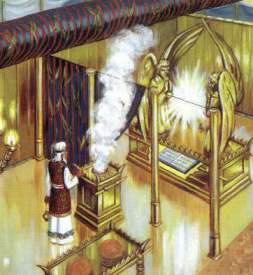
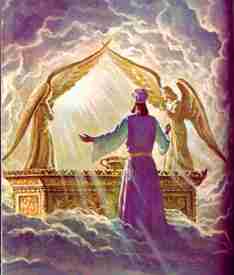
In addition to obstructing the regular offerings of the heavenly sanctuary, Daniel sees in his prophetic vision that “the place of the sanctuary was cast down.” Cast down from where? “Cast down” simply means “overthrown”. The word for “cast” is “shalak“, and the same root word is used elsewhere in Daniel to describe a figurative overthrowing rather than a temple literal falling from heaven. It is during this briefly successful overthrowing of the heavenly sanctuary that the invading Antichrist alongside his earthly and demonic forces will set up the “abomination of desolation”—the Antichrist himself proclaiming himself to be God. As I mentioned before, this was indeed the original goal of Nimrod and the royal family heads alongside him—“We will ascend into heaven and fight against him; the second said, We will ascend to heaven and place our own gods there and serve them; and the third part said, We will ascend to heaven and smite him with bows and spears.” (Jasher 9:25,26) That goal to place their own gods in the heavenly temple is exactly what the Antichrist in Daniel’s prophecy is said to finally achieve, so it is not farfetched to see the Antichrist as a revived Nimrod accomplishing to some degree what he originally set out to do.
It’s also not difficult to see such a feat accomplished in an age of advanced technological air travel, space flight, and devastating weaponry such as a hypothetical antimatter bomb created at CERN. Even if the Tower of Babel failed, God said in Genesis 11:6, “If as one people speaking the same language they have begun to do this, then nothing they plan to do will be impossible for them.” This passage may signify that, even if their tower was an impractical method to reach Heaven, their united will power would eventually devise a more successful way—rockets, perhaps?
HEAVEN
I know it seems impractical to think that space flight could ever reach Heaven, but we have to be open to the possibility that our entire understanding of the world’s cosmography may be radically different than we’ve always been led to believe. We must be willing to accept that our gravest mistake may have been believing government organizations like NASA over the Word of God. Seeing as they’ve already been caught faking much of their “authentic” space footage, who’s to say that NASA hasn’t been lying about other things? We cannot definitively say that Heaven isn’t a real place sitting just above the earth’s atmosphere without arriving at the assumption that NASA is telling us the truth. But we Christians should know by now—we live in a world controlled by avaricious secret societies that rule the world under the worship of Satan himself, and those with knowledge hold power over those who don’t. For the sake of maintaining the masses’ disbelief in God so that people might be enslaved in their daily grind of life to serve the wealth system of the rich, those with the biggest, most sophisticated telescopes (i.e. the Vatican and the U.S. government) might be keeping the biggest secret in history. If the ancient accounts were correct and the shape of the earth is a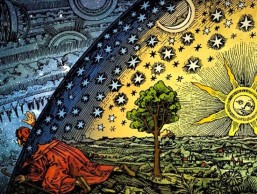 flat disk, and the sun is just above our clouds beneath the sky’s vaulted ceiling, you have no reason to believe that NASA is reliable to tell you the truth about it. The organization that sculpted our understanding of the universe is the same group that released footage of astronauts “in space” while air bubbles could be seen wriggling up from their (underwater) helmets, and pictures from “Mars” identical to their Canadian Mars simulation site on Devon Island, and zero gravity film tricks no better than the simple illusions we see in every sci-fi blockbuster from Hollywood. Let’s not even get into the Apollo 11 mission.
flat disk, and the sun is just above our clouds beneath the sky’s vaulted ceiling, you have no reason to believe that NASA is reliable to tell you the truth about it. The organization that sculpted our understanding of the universe is the same group that released footage of astronauts “in space” while air bubbles could be seen wriggling up from their (underwater) helmets, and pictures from “Mars” identical to their Canadian Mars simulation site on Devon Island, and zero gravity film tricks no better than the simple illusions we see in every sci-fi blockbuster from Hollywood. Let’s not even get into the Apollo 11 mission.
So, back on topic—if it’s possible that Heaven is not beyond some science-fiction-inspired inter-dimensional portal, but is in fact a very literal place located above the ceiling of the sky, then the Genesis account of water existing above the sky may be less insane than we’ve been told. The great apocalyptic opening of the skies at the sixth seal of Revelation might be the parting of these upper waters through which the raptured saints are taken up to Heaven, symbolized by the parting of the Red Sea through which Moses liberated the Israelites from Egypt. Also in the sixth seal, we read that the stars begin to hit the earth only shortly after people begin to see them fall—“the stars of heaven fell unto the earth, even as a fig tree casteth her untimely figs, when she is shaken of a mighty wind.” (Revelation 6:13) This means that all of our textbook facts about the stars existing lightyears away were, in fact, greatly exaggerated.
Perhaps this great day of the Antichrist’s invasion of the heavenly sanctuary is not so far off after all. I reckon the Devil himself and the rebel angels will all be fighting alongside the Antichrist in the spiritual realm. It will be an abomination to cap all abominations; however, this desolating sacrilege will only last so long. “From the time that the daily sacrifice is abolished and the abomination that causes desolation is set up, there will be 1,290 days.” (Daniel 12:11)
What happens next? Let’s read Revelation 12:
“A great sign appeared in heaven: a woman clothed with the sun, with the moon under her feet and a crown of twelve stars on her head. She was pregnant and cried out in pain as she was about to give birth. Then another sign appeared in heaven: an enormous red dragon with seven heads and ten horns and seven crowns on its heads. Its tail swept a third of the stars out of the sky and flung them to the earth. The dragon stood in front of the woman who was about to give birth, so that it might devour her child the moment he was born. She gave birth to a son, a male child, who ‘will rule all the nations with an iron scepter.’ And her child was snatched up to God and to his throne. The woman fled into the wilderness to a place prepared for her by God, where she might be taken care of for 1,260 days.”
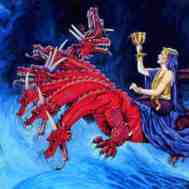 Although this is symbolic language, it’s clearly depicting a very real event. Who is the “enormous red dragon” mentioned in the passage? We already read about him earlier in the article. He’s the scarlet beast on which the whore of Babylon rides in Revelation 17. In both chapters, this monster is described as being red in colour with seven heads, seven crowns, and ten horns. So, if they are the same, then the red dragon we are reading about here in Revelation 12 is the scarlet beast of Revelation 12, whose seven heads are the seven types of Antichrist and their seven historical kingdoms, accumulated into one final amalgamation. Mind you, the final eighth king, the Antichrist, is one of the seven historical kings, which means that one of the red dragon’s seven heads is the final Antichrist himself. This is the end-time worldwide political force that wages war against God and the remainder of His chosen people on earth, as well as the angelic army of Heaven itself, as evinced by Daniel 8:9-12.
Although this is symbolic language, it’s clearly depicting a very real event. Who is the “enormous red dragon” mentioned in the passage? We already read about him earlier in the article. He’s the scarlet beast on which the whore of Babylon rides in Revelation 17. In both chapters, this monster is described as being red in colour with seven heads, seven crowns, and ten horns. So, if they are the same, then the red dragon we are reading about here in Revelation 12 is the scarlet beast of Revelation 12, whose seven heads are the seven types of Antichrist and their seven historical kingdoms, accumulated into one final amalgamation. Mind you, the final eighth king, the Antichrist, is one of the seven historical kings, which means that one of the red dragon’s seven heads is the final Antichrist himself. This is the end-time worldwide political force that wages war against God and the remainder of His chosen people on earth, as well as the angelic army of Heaven itself, as evinced by Daniel 8:9-12.
Notice also how it says “The woman (true Israel) fled into the wilderness to a place prepared for her by God, where she might be taken care of for 1,260 days.” That’s almost as long as “1,290 days”, the amount of time that the Antichrist’s abomination in the heavenly sanctuary is said to last in Daniel 12:11. In Matthew 24:15, Jesus tells us, ”So when you see standing in the holy place ‘the abomination that causes desolation,’ spoken of through the prophet Daniel—let the reader understand—then let those who are in Judea flee to the mountains.” Just as in Revelation 12, we see an image of the Jews fleeing their home to live in the wilderness at the start of this invasion of the heavenly sanctuary.
And again, I can’t stress this enough—Jesus, quoting Daniel, was NOT referring to a rebuilt temple in Jerusalem. The coming of the Holy Spirit at Pentecost, which Jesus Himself had promised, was the dwelling of God’s Spirit within the temple of each believer, which is their body. “Do you not know that your bodies are temples of the Holy Spirit, who is in you, whom you have received from God?” (1 Corinthians 6:19-20) There is only one “holy place” that Jesus and Daniel could have been referring to, and that is the very temple of Heaven above.
During this time of the heavenly invasion, the true Jews who fled Judea are now hiding in the mountains of the wilderness for the appointed extent of time. Revelation 12 continues with verses 7-9, “Then war broke out in heaven. Michael and his angels fought against the dragon, and the dragon and his angels fought back. But he was not strong enough, and they lost their place in heaven. The great dragon was hurled down—that ancient serpent called the devil, or Satan, who leads the whole world astray. He was hurled to the earth, and his angels with him.”
This “great dragon” is not only the Devil himself, but the same great seven-headed dragon that symbolizes the Antichrist and his earthly forces, present in heaven making war with Michael and the angels of God alongside Satan’s demonic army. Remember, this great heavenly war was Nimrod’s original plan, as we read in the Book of Jasher.
If in the sixth seal of Revelation the skies roll back to reveal the Kingdom of Heaven above, then it stands to reason that this open view of Heaven now permits earthly forces to fly up and attack it. In Daniel 8:19, the angel telling the prophet of this future war in heaven says, “Behold, I will make thee know what shall be in the last end of the indignation: for at the time appointed the end shall be.” The Book of Daniel specifies that the Antichrist’s war on Heaven takes place during the last end of the indignation”, that is, in the last part of God’s wrath—1,290 days, to be precise—which comes after the sixth-seal opening of the sky, so it’s plausible to conjecture that the opened sky is what makes an invasion from earth to heaven possible sometime after the sixth seal.
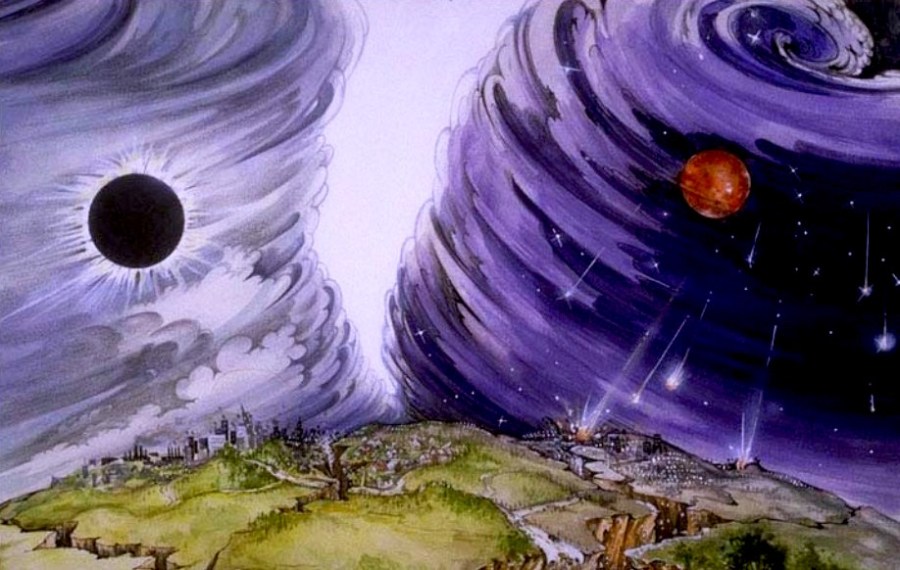
I know a lot of this can sound quite fantastical and farfetched, but seeing the surreal sci-fi era of super-intelligent technology and weaponry that we are currently advancing into, I don’t actually find it all that hard to believe. I think we need to wake up from our slumber and start taking the Bible at its word; after all, it is the very word of God, even if it sounds inconceivable within our current understanding. And you may be asking: why would God allow, and even predestine, the Antichrist, a man, to succeed as far as entering heaven and overthrowing the true sanctuary itself? Remember, this is the last thing that happens before the evil army is defeated in battle and finally cast down to earth where the Antichrist and all his forces perish in the plain of Armageddon. The usurping of heaven is only temporary, and it will serve as the pinnacle of iniquity, to cap sin with one last ultimate act of the greatest evil before the eternal kingdom of Christ brings in everlasting righteousness. It will prove exactly how evil mankind is by displaying how far people are willing to go to rebel against God—as far as heaven itself. After the point is made, the flame of Satan’s conquest is stamped out forever.
“Michael and his angels fought against the dragon; and the dragon fought and his angels, and prevailed not; neither was their place found any more in heaven. And the great dragon was cast out, that old serpent, called the Devil, and Satan, which deceiveth the whole world: he was cast out into the earth, and his angels were cast out with him. And I heard a loud voice saying in heaven, Now is come salvation, and strength, and the kingdom of our God, and the power of his Christ: for the accuser of our brethren is cast down, which accused them before our God day and night.” (Revelation 12:7-10)
Amen!
